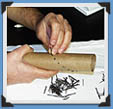|

- Cardboard tube (a paper towel roll is okay, but a long tube from gift-wrapping
paper is even better. You can also take two or three paper towel rolls
and tape them together.)
- Marker
- About 60 1-inch nails
- Tape (masking or packing
tape is good)
- Paper
- Rice and/or small beans
(uncooked!)

1.
Paper
tubes have a spiral seam. Use a marker to draw dots about half an inch
apart, all the way down the spiral seam of the tube.

2.
Poke a nail all the way in at each dot. (Make sure the nails
don't poke
 through the other side of the tube.) You'll need about 30 nails for
each paper towel tube.
through the other side of the tube.) You'll need about 30 nails for
each paper towel tube.
3.
Wrap tape around the tube to hold the nails in place.
4.
Cut two circles of paper just a little bigger than the ends
of the tube. Tape one of the circles over one end of the tube. Cover
the circle with tape so the whole end of the tube is sealed shut.
5.
Put a handful of rice or beans into the open end of the tube.
Cover the open end with your hand, and turn the tube over. Add more
rice or beans until you like the sound. (Beans will make a harder sound,
and rice will make a softer sound.)

6.
Put the second circle of paper over the open end of the tube,
and seal that end shut with tape.
7.
Your rain stick is complete. Turn it over and listen to the
rain.

The rain stick is a musical instrument from South America. Traditionally,
rain sticks are made from the wood skeleton of a cactus. First, the
thorns are pulled off and pushed back through the soft flesh of the
cactus. Then the cactus is left in the sun to dry--with the thorns on
the inside. Later, the hollow cactus is filled with small pebbles, and
the ends are sealed with pieces of wood.
Adapted from
The
Science Explorer
, a book of science activities for families from
the Exploratorium, published by Henry Holt & Co., ©1996. The Science
Explorer series is available at the
Exploratorium
Store
.
©
1999
Exploratorium
|